|
In Control Panel, plans are created with Plan Creation Wizards
that are available from the Info menu:
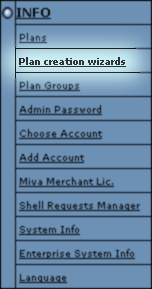
On the page that appears, choose the type of the plan.
We will take a careful look only at the Unix Plan Wizard.
For other wizards, we will provide only peculiarities:
Unix Plan Wizard
Step 1
On the first step you define resources to be included in the plan and initialized
during signup (the Include box). You can also choose whether the resource
should be enabled immediately at signup or activated later by the user (the
Activated box). In the latter case if it is a paid resource the signup
bill won't include the fee for that resource.
* Some of the plan's resources are integral to the system and cannot be excluded
from the plan. They are not available on this page.
The form consists of several sections:

- enter a name for the plan you are creating.
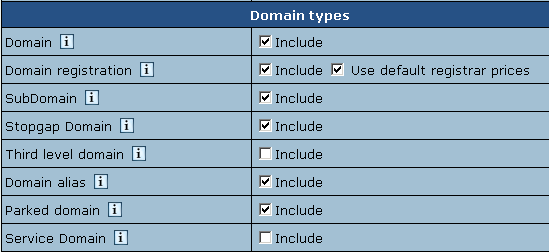
- Domain: if you leave this box unchecked, domain transfer and
OpenSRS registration will be disallowed.
- Domain registration: allow users to create new standard domains
through OpenSRS.
* It's required the Domain to be included. For more information, refer to http://www.opensrs.org/faq.shtml.
- SubDomain: allow users to create subdomains. Subdomains have the
same functionalities as regular domains.
- Stopgap Domain: allow your customers to use hosting services without
a real domain. Stopgap domains don't have DNS zones, and don't allow e-mail
service. Still, users can access their sites using their instant
domain aliases.
Stopgap domains support web site management and FTP services. Also, IP-only
access is possible with a dedicated IP.
- Third level domain: allow your customers to create third level domains
based on the domain names you offer. E.g. if your domain name is besthosting.com,
a user can have a domain like thirdlevel.besthosting.com. Third level
domains have the same functionalities as second level domains, i.e. regular
domains.
- Domain alias: (also referred to as stack domain) an extra
domain name that points to a 'primary' domain. For example, the owner of the
domain name company.com can register another domain name, e.g. company.net
and have it point to the location of company.com. This means that every
Internet user who goes to company.net will land in company.com.
Domain alias can have its own DNS zone, custom DNS records and mail service.
- Parked domain: allow your customers to use Control Panel DNS server for
designating IPs to domain names serviced and hosted on other servers (not
those of Control Panel).
- Service Domain: should be included only for the administrative plans
(like System plan) to host and manage your corporate website. To enable
users register third level domains with the second level domain name of your
corporate site, register it as a service domain. For example, the company
offers third level domains at besthosting.com, such as thirdlevel.besthosting.com
or userdomain.besthosting.com. Naturally, the site of the hosting
company should have the second level domain name, i.e. besthosting.com.
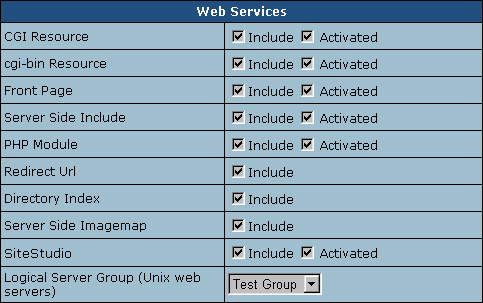
- CGI Resource: allow your customers to map file extensions as CGI
executables.
- cgi-bin Resource: allow your customers to create cgi-bin directory,
so all the cgi-bin directory's content is treated as cgi executables which
the server tries to run.
- Front Page: allow your customers to use FrontPage extensions on their
web sites.
- Server Side Include: allow your customers to use interactive real-time
features such as echoing current time, conditional execution based on logical
comparisons, querying or updating a database, sending an e-mail etc., with
no programming or CGI scripts.
- PHP Module: allow your customers to create dynamic web pages with
PHP.
- Redirect URL: allow your customers to redirect visitors from one
URL to another. When an Internet user tries to connect to a URL that is redirected,
he is taken to the address this URL is mapped to.
- Directory Index: allow your customers to set their custom directory
indexes (version 2.09 and higher)
- Server Side Imagemap: allow your customers to have files with a specific
extension regarded as map files (version 2.08 and higher)
- Site Studio: allow your customers to use a powerful site construction
tool enabling them to create a professional-looking site in a matter of minutes
(version 2.09.5 and higher).
- Logical Server Group: appropriate resources under this plan will
be created on a particular logical server group.
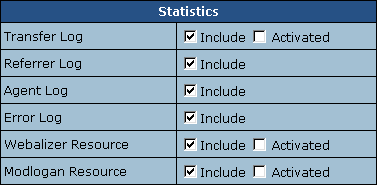
- Transfer Log: check the boxes to have transfer logs written into
user directories. Transfer logs include combined data about every visit to
your customer's site, including:
- Remote host IP (i.e. visitor's IP)
- Time of request (i.e. when visitor requested the page)
- First line of request
- Error generated by request, if any
- Size of message sent in response to the request
- Referrer (i.e. from which page visitor was directed)
- Agent ID (i.e. type of browser or another agent and
related information, such as user's OS, etc.)
- Referrer Log: check the box to have separate
referrer logs written into user directories. Referrer logs
contain the URLs from which visitors were referred to your
customer's site.
- Error Log: check the box to have separate error logs written
into user directories. Error logs store data about errors generated by the
server (e.g. Page Not Found error) or by their cgi scripts.
- Agent Log: check the box to have separate agent
logs written into user directories. Agent logs contain data
about visitors' browsers or any other Internet-based software,
and related data.
- Webalizer Resource / Modlogan Resource:
Check the boxes to install Webalizer and Modlogan into user
directories. These two programs parse the transfer log and
produce statistics reports in readable HTML format to be
viewed through a browser.
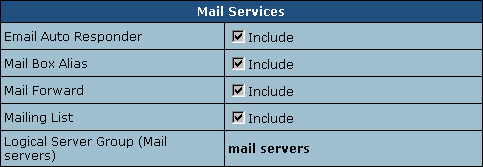
- Allow or disallow creating the above mail resources by your customers.

- SSL Module: enable your customers to use SSL (Secure Sockets Layer
protocol) - a standard for transmitting confidential data such as credit card
numbers over the Internet.
- Shared SSL: provide SSL (Secure Sockets Layer) encryption and business
authentication to Web business customers.
- Miva Resource: allow your users to create online stores with MivaMerchant.
For more information visit www.miva.com/products/merchant/
- osCommerce: allow your users to create online stores using an open
source e-commerce solution (osCommerce 2.1 release). For more information
visit www.oscommerce.com.
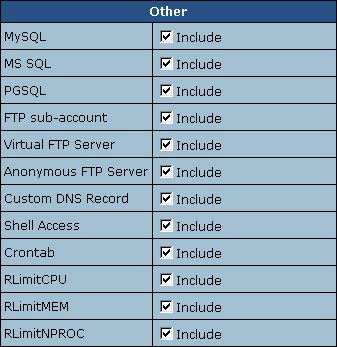
- MySQL, MS SQL, PGSQL: allow or disallow your customers to create
and use their own databases. See also: Is
Billing the Same for All Resources?.
- FTP sub-account: allow or disallow your customer to create additional
logins and passwords to his directory so his friends or colleagues can independently
use it.
- Virtual FTP Server: allow or disallow your customers to let their
friends and colleagues download, upload or view files in the dedicated directories.
- Anonymous FTP Server: allow or disallow your customers to let anybody
else download, upload or view files in the dedicated directories.
- Custom DNS Record: allow your customers to create new custom DNS
records.
- Shell Access: allow your customers to access and operate their accounts
through Shell.
- Crontab: enable your customers to clock and run their own Unix shell
scripts automatically.
- RLimitCPU: checking the box will restrict the CPU usage by users'
cgi scripts.
- RLimitMEM: checking the box will restrict the memory usage by user'
cgi scripts.
- RLimitNPROC: checking the box will restrict the number of simultaneous
processes per user.
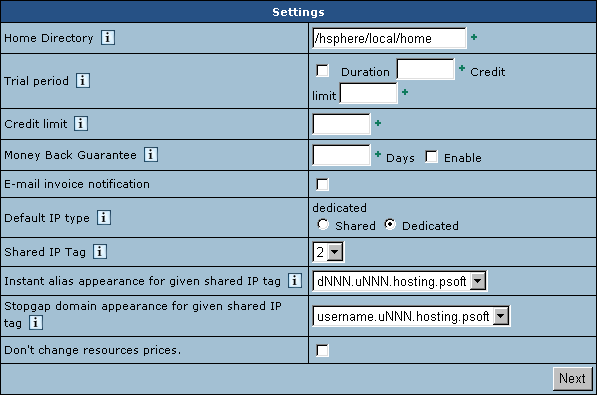
|
Name
|
Meaning
|
Recommended Value
|
Notes
|
|
Home Dir
|
The directory on the server where user home dirs under this plan will
be stored. If you need to put all accounts under this plan in a separate
directory, create this directory first and set permissions based on your
security policy. New accounts under this plan will be stored in the defined
directory.
|
Leave as is
|
For Unix-based plans this directory MUST be 3-level as the default, for
example: /IT Services/local/unixgold. Otherwise the traffic will fail to be
calculated.
|
|
Billing Type
|
Paid: no trial period available |
|
Don't switch to without billing. |
Trial: paid plan with trial period available.
Check the box to enable trial registration for this plan. If the box is
checked, you will have to fill in the following fields too:
- Duration: enter the duration of the trial period in days. Usually
trial period does not exceed one month.
- Credit Limit: maximum amount of credit a trial user can run up
acquiring paid resources. If you set Trial Credit Limit to zero, trial users
will be able to acquire only free resources. Usually this amount either
equals the initial registration payment plus the recurrent fee for one payment
period, or exceeds it a bit to enable trial users to buy some extra resources.
After this amount has been reached, the user cannot purchase any more resources.
When trial users become pay users, they are charged the amount they have
run up during the trial period. |
Checked |
Decreasing the trial period affects already signed up trial users so their
trial time is 'cut'. Their accounts can be suspended if they have had their
accounts more than the trial period is set to. |
|
Without billing: a totally free plan. Accounts registered without
filling in the billing forms.
|
|
Don't switch to paid.
|
|
Credit Limit
|
Amount of account's 'expenses' to be accumulated until it is charged.
Credit limit serves two purposes:
-cumulative: All setup, recurrent and usage fees are accrued until
their cumulative amount reaches or exceeds the credit limit. Only then
is this amount charged. This method minimizes referrals to credit card
processing centers. This purpose is not applicable to check payments.
-restrictive: This purpose is pertinent to invalid credit, broken
or expired cards and check payments. After user's negative balance reaches
the credit limit, the user cannot buy any more resources. However, the
recurrent and usage fees are still accrued, so the negative balance increases
with every new payment interval.
Example: If you set the credit limit to $10, a user with $0 balance
purchasing $5 resource won't be charged, although his balance will become
-$5. This is also true of invalid credit card or check payment. If he
decides to buy some extra $10 resource, he will be charged $15, and his
balance will become zero. But in case of invalid credit card or check
payment, this user won't be able to buy these extra $10 resource, and
his balance will remain -$5. If this is the case, and if his usage fee
equals $20, at the end of the payment interval his debt will increase
to $25.
|
About $10
|
Changing Credit Limit affects both existent and new accounts.
|
|
Money Back Guarantee
|
the period in days after pay registration when users can claim back the
recurrent fees they have paid if they decide to quit hosting services.
The Money Back amount does not include the Setup Fees and is not affected
by the refund percentage. The blank field sets it to zero, which disables
the feature.
|
Less than 1 billing period
|
Immediately takes effect and influences existent accounts.
|
|
E-mail Invoice Notification
(version 2.1 and higher)
|
set the system to send e-mail invoices to users with accounts
registered under the plan.
|
|
- e-mail invoices are sent to the e-mail address user provides in his
billing info or contact info (in the absence of the first)
- the default can be overridden by individual user settings
- toggling the option doesn't affect settings of the existing users
|
|
Default IP type
|
Define the kind of IP user domains will get at signup (shared or dedicated).
Each new user to signup for this plan will be given this kind of IP.
|
Shared
|
1. In the case of dedicated IPs, when you run out of dedicated IPs, newcomers
won't be able to signup.
2. Changing this parameter doesn't affect existent domains. Only new domains
created under reconfigured plan will get the defined IP type. This is
done either at signup or in the existent account.
|
|
Shared IP Tag
|
a digital "mark" that is assigned to all accounts created under
this plan. All sites located on the same logical host are usually assigned
the same shared IP. The Shared IP Tag allows to dedicate a different shared
IP to a group of sites. Examples:
- you can use different shared IP tags to host sites in different plans
on different share IPs;
- you can create different shared IP tags to host your own end customers
and end customers of your resellers on different shared IPs;
- you can create different shared IP tags to use different wildcard certificates
for you (the parent hosting company) and your resellers;
- you can set a different shared IP tag for sites of explicit nature.
This may become necessary as many corporate firewalls filter sites are based
on their IP, not domain name, which may affect the accessibility of other
sites with the same IP address.
To use this feature you must already have this tag (or tags) defined for
every logical host (see also Configuring
Your DNS Settings).
|
2
|
You mustn't change the shared IP tag in the Window based plans, unless
there are no live users under them.
In Unix based plans changed shared IP tag immediately shows up in the
system control panel interface, however it actually takes effect only
when the changes to the server configuration are applied.
|
|
Instant alias appearance
for given shared IP tag
|
Select a template to create user instant aliases. Instant aliases are
based on your domain names and allow users to view their sites without
using their own domains. The example of an instant alias appearance is
username.kNNN.besthosting.com, where kNNN is the name of the logical server,
on which user's account is located.
|
|
Changes to this parameter will apply only to new domains, while the existent
domains will retain the 'old' shared IP tag.
|
|
Stopgap domain appearance
for given share IP tag
|
Select a representation for user stopgap domains. Stopgap domains will
allow users to maintain their sites and access them using instant domain
aliases. Stopgap domain is not a real domain and does not allow the user
to have any domain name, DNS zone, and e-mail service. However, stopgap
domain users can have IP-only access if they purchase a dedicated IP.
|
|
Changes to this parameter will apply only to new domains, while the existent
domains will retain the 'old' shared IP tag.
|
Step 2
Set the default billing period prices for the resources you have included in
the plan.
* For more information on prices, please
to Editing
Plans and Prices.
After filling in all fields just press the "Create" button,
and the desired plan will be created.
See the example screenshots of unix plan
configuration.
Unix RealMedia Plan Wizard
MySQL Plan Wizard
The plans created with this wizard allow customers only to
create and use MySQL online databases. The customer can authorize
individual Internet users to connect to the MySQL database
and use it from any remote location.
Windows Plan Wizard
Windows plans are created similarly to Unix plans (see Unix
Plan Wizard). The only difference is that you can include
ASP resource to enable your users maintain sites created
with the means of ASP and ColdFusion Module to enable
your users to maintain sites created by ColdFusion (Third
party commercial products such as ColdFusion, MS SQL server,
Real Server, and Miva are purchased separately and should
be installed prior to Control Panel)
Note: in version 2.07 and higher you can't create
Windows plans, unless you have 'Windows' physical servers.
Not configured means that your system lacks servers
pertaining to the services to be run under the plan.
Windows RealMedia Plan Wizard
In version 2.07 and higher you can't create Windows RealMedia
plans unless you have a winbox with properly configured RealServer.
E-mail Plan Wizard
E-mail plans are created similarly to Unix plans (see Unix
Plan Wizard). The only difference is that they don't include
any resources other than domain, mail and Custom DNS record.
Stopgap domains are not supported.
Regulating the overall number of resources that can be
created
To set the maximum number of resource units a user can buy
under this plan, go to INFO -> Plans -> Resource ->
Edit (next to the selected resource) -> the Max field
Administrator Plan Wizard
Use this plan to create administrative plans:
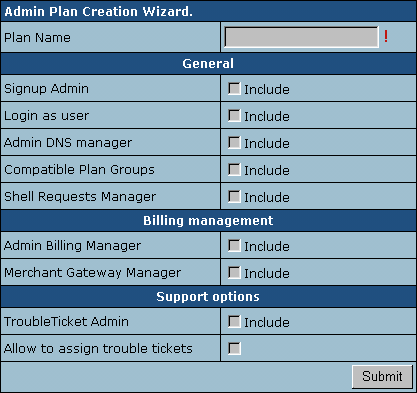
- Signup Admin: allow the admin to sign up new users.
- Login as user: allow the admin to log into users'
accounts.
- Admin DNS manager: allow the admin to manage DNS
settings.
- Compatible Plan Groups: allow the admin to arrange
plans in groups.
- Shell Requests Manager: allow the admin to acknowledge
users' shell access requests.
- Admin Billing Manager: allow the admin to debit
and credit users' accounts.
- Merchant Gateway Manager: allow the admin to configure
merchant gateways.
- TroubleTicket Admin: allow the admin to answer
users' trouble tickets.
- Allow to assign trouble tickets: allow the admin
to assign users' trouble tickets to other tech support members.
|